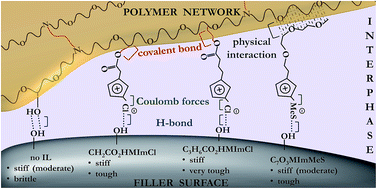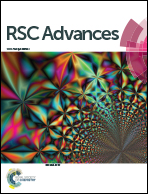Epoxy–silica nanocomposite interphase control using task-specific ionic liquids via hydrolytic and non-hydrolytic sol–gel processes
Abstract
Carboxylic-functionalized task-specific imidazolium ionic liquids (carboxylic-ILs) presented selective high reactivities with epoxy-functionalized compounds, even in highly complex epoxy–silica nanocomposite systems. The carboxylic-ILs induced the in situ covalent bonding with epoxy based materials and tuning of the nanocomposites’ filler–matrix interphase when applied either via hydrolytic or non-hydrolytic sol–gel processes. Structural modifications in the carboxylic-ILs allowed fine morphology control and promoted the formation of well dispersed silica nanodomains. This approach resulted in nanocomposites with improved mechanical properties, without a negative effect on the glass transition temperature, for both rubbery and glassy epoxy–silica nanocomposite systems with a very small IL content (∼0.2 wt%). The best properties were achieved with the application of IL 1-carboxypropyl-3-methylimidazolium chloride, which produced a toughness increase of more than 7 times for the rubbery and almost twice for the glassy epoxy systems, when compared to their IL-free equivalents. These easy and quick procedures to produce imidazolium functionalized materials have the potential to open up a broad range of new conductive, responsive, smart and tunable reinforced materials.


 Please wait while we load your content...
Please wait while we load your content...